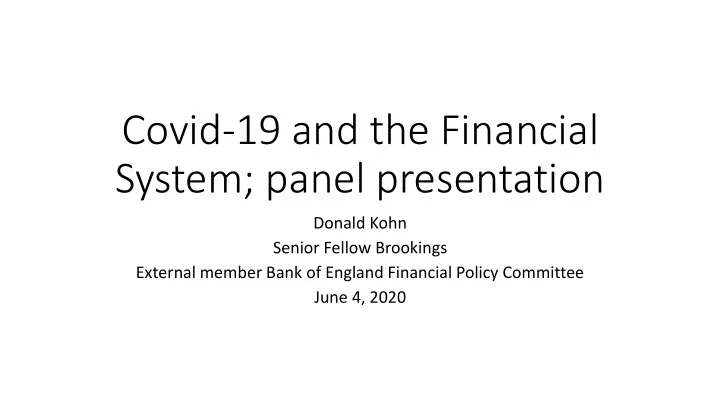

Covid-19 and the Financial System; panel presentation Donald Kohn Senior Fellow Brookings External member Bank of England Financial Policy Committee June 4, 2020
Main points • I agree with the thrust of the recommendations of Blank et al. • Now is the time to conserve, if not build, resilience, so suspend dividends. • This stress event could be more severe than the Fed’s severe scenario. • Banks are key intermediaries to keep credit flowing and reduce scarring. • For the future, the US needs a more countercyclical capital regime, with active use of the countercyclical capital buffer (CCyB). • A regime built around dynamic resilience is entirely possible — the FPC in the UK has done it. • The US capital regime was moving in the wrong direction before this stress event — capital requirements from the stress test had fallen and the stress test framework was becoming considerably less countercyclical.
Dynamic resilience framework in the UK • The CCyB had been 1 in a standard risk environment but was on its way to 2. • Would have needed 3- 1/2 to 5 in 2008, and wouldn’t get there from 1. • Going from 1 to 2 would have added around .35 to tier 1 capital requirements. • Stress test keyed to economic and financial cycle informs the setting of the CCyB • Has produced increases in stress test capital drawdowns over recent years, driven importantly by rising global risks. • Releasing the CCyB can be an effective macroprudential tool to encourage banks to lend in a stress event. • Adds to capital that can be drawn down before distribution restrictions apply
Dynamic resilience framework in the UK • FPC has released the CCyB twice. • In market volatility after Brexit referendum • For Covid-19 stress. • NB: Neither stress originated in the financial system, but tightening financial conditions threatened amplification. • And it has emphasized that “buffers are usable”, including the capital conservation buffer. • Buffers serve two purposes: • Getting capital high enough to avoid failures- – especially for systemically important institutions • Being drawn down in a stress to keep lending flowing • This is a test of #2 • Will markets tolerate declines in capital and liquidity metrics? • Will banks test market tolerance? Are they willing to draw down into distribution restriction territory (even with dividends and buybacks already restricted)?
The US is going in the wrong direction • The stress test is said to be the marginal capital constraint for large banks • The capital buffers implied by the stress test fell in 2019 — arguably procyclical as the unemployment rate fell and business leverage rose. • The starting point in a stress is critical; the large increases in capital and liquidity stemming from regulatory reforms after 2009 have meant that banks have had a constructive role to play in 2020; the 2019 stress test implied the authorities were OK with the starting point declining.
The US is going in the wrong direction • Changes to the stress test regime have weakened its countercyclicality • Much of what countercyclicality there had been came from the requirement to prefund eight quarters of dividend and share repurchases. • That’s been scaled back to four quarters of dividends. • The “soft limit” of 30% on dividends as a proportion of distributions has been eliminated, allowing dividends to rise relative to share buybacks. As we have seen in 2020, buybacks are much easier to scale back than dividends in a stress. • The test now assumes a constant balance sheet rather than the small increase that had been assumed before, running counter to the messaging that banks should be able to lend in bad times as well as good.
Recommendation to US authorities • Use the current experience to re-evaluate the public-interest costs and benefits of your direction of travel. • The US should adopt a framework of “dynamic resilience”, with a positive CCyB in standard risk environments. • Financial stresses don’t always originate in the financial sector, so waiting until financial risks are already elevated to have a positive CCyB can be too late. A CCyB in a standard risk environment will allow authorities to lower requirements to encourage lending wherever the stress originates. • Capital requirements should yield capital levels in a standard risk environment that are sufficiently high to allow both markets and microprudential regulators to be comfortable when the CCyB is released.
Recommend
More recommend